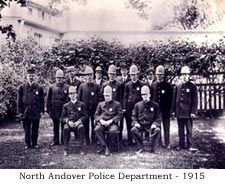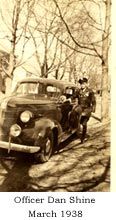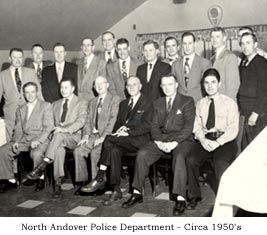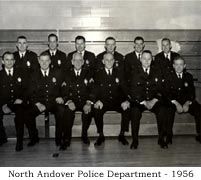Police Department History
Sarah Loring Bailey, in Historical Sketches of Andover, quotes from the early County Court papers:
"To the Constable of Andover. You are hereby required to attach the body of John.....to answer such complaint as shall be brought against him for stealing several things as pigs, capons, malt, bacon, butter, eggs and for breaking open a seller door in the night - several times. "
The accused was a servant of Mr. Simon Bradstreet. The date was March 7, 1661.
On April 3, 1797, the town meeting voted to "recommend to the inhabitants of the town to form themselves into Voluntary Associations, for the purpose of detecting thefts that may be committed in town."
They also voted that "any person who shall detect a thief that shall steal any of the town property or the property of any of the inhabitants of the town (provided the thief shall be prosecuted to conviction) shall receive a reward to be paid out of the town treasury of the sum of ten dollars provided the property thus stolen shall amount to that value, and when the property stolen shall not amount to the value of ten dollars, the reward shall be equal to one half of the value of the goods stolen."
Rules were specified, such as, "no...cattle should be permitted to go at large except the poor men's cows, who shall get a permit from the selectmen for one cow and not more and they shall have a strap with a particular mark upon it around their necks as the selectmen direct."
It was not until the town meeting of November 8, 1864, that voters required selectmen to build or provide a suitable place for a lock-up. On the petition of George L. Davis, the founder of Davis and Furber, and twenty five other residents, this lock-up was to be located in the Merrimack School District, what we no know as the southerly side of Second Street, on land owned by Miss Rebecca O. Bridges.
The lock-up was built in 1865. The total cost, including furnishings, was $606.40. Peter Holt and Son, Contractors, received $550.00 for building the structure. Miss Bridges continued to own the land and was paid $6 annually by the town for its use. (She was the daughter of Colonel Moody Bridges, who's own home was on the west side of Elm Street near is juncture with Main Street. Across the street there was then a small school house where Miss Bridges conducted a private school for the town children.)
 Miss Bridges died in 1871; her heirs sold the lock-up lot, a little over an acre, for $650 to Thomas Daw. The annual rent for the land was increased by Mr. Daw to $12. This raised the question of whether to keep the lock-up. In 1875, that was decided by the sale of the building at public auction on July 12th to George Morton, for $165. The following day it was moved to the corner of Water and Church Street. A brick foundation was placed under it, giving enough room for a shop to be located there.
Miss Bridges died in 1871; her heirs sold the lock-up lot, a little over an acre, for $650 to Thomas Daw. The annual rent for the land was increased by Mr. Daw to $12. This raised the question of whether to keep the lock-up. In 1875, that was decided by the sale of the building at public auction on July 12th to George Morton, for $165. The following day it was moved to the corner of Water and Church Street. A brick foundation was placed under it, giving enough room for a shop to be located there.
R.A. McKone, publisher of the North Andover Advertiser at that time, remarked: "The moral standing of this town needs no better argument in its favor than the fact that it don't pay to keep a lock-up there."
This small building has been in constant use since then. George F. Harris rented the first floor of the remodeled lock-up in October of that year for a confectionery store. The horse railroad company established a station there. Mr. Harris also bought the rights to sell the Sunday Herald there from Ben Brierly. Meanwhile the lock-up itself has been used as the meeting place for the North Andover Whist Club and as an apartment rental.
Not until eighteen years after the establishment of the lock-up did the town meeting of 1883 formally establish a police department. The original one was made up of a chief and 12 men - 6 appointed by the selectmen and 6 constables elected by the people. Town year end reports beginning in 1856 write of the payments to these constables for services rendered. Expenditures listed were "notifying town officers: $5" or "warning Town Meetings: $3"
Enos S. Robinson was appointed the first chief in 1883, succeeded by George I. Smith in September, 1884. All officers were paid 25 cents an hour, monthly. The highest amount paid to any one officer that first year was $31.45; the total salary budget was $212.95.
In a year end report by Chief Robinson, police department property consisted of 15 police badges and 12 pairs of handcuffs. There was a total of 15 arrests, 2 for simple intoxication. There were 74 other reported incidents that did not conclude in arrest, including 15 for gaming and 25 for intoxication.
In 1886, the old Merrimack Engine #1 office (where the current bank is on the corner of Main and Water Streets) was fitted for a selectman's office after the engine was sold. Newton P. Frye's report in September, 1891, says that the selectman had built a lock-up in the basement of the building and made a court room on the second floor, "but by what authority I do not know."
Obtaining a lock-up had been important to the police, for any prisoners they had to detain were taken to Lawrence. In Chief Harris' report in January, 1888, he said,
"Going to Lawrence, especially in the night, is not a pleasant duty, and I would recommend that the Town furnish a suitable place for the safe keeping of those arrested which place could also be used for the care of tramps, thus saving the keeper of the Poor Farm considerable trouble; and I believe that it would also be a saving to the Town. The Supreme Court having decided the fish cases in favor of the Town, I propose to prosecute all persons caught fishing illegally.
The Andover Townsman records some of the early activities of the police:
April 26, 1889: "The tramps who were found disporting themselves in an unbecoming manner were taken to Lawrence...and were locked up for safe keeping. They had recently been discharged from penal institutions."
June 14, 1889: "The sounds of revelry of the late comers on the 'last car' received a summary check by police officers Saturday night."
April 5, 1889: "News reached chief-of-police Rextrow about three weeks since of the card playing and disorderly conduct of persons in the vicinity of Sutton's Corner, Sundays, and last Sunday evening it was determined to take measures to check such a condition of things. Accompanied by Officer Gile, he visited the house near the B. & M. crossing set apart for the use of younger boys who compose the Sutton Club; the latter, however, have been ejected therefrom, and the room has been occupied lately by the aforementioned parties. On learning the true state of affairs, Chief Rextrow sent for the remainder of the force officers, Harris, Mizen and Crowther, and, surrounding the building, entered with Officer Harris and arrested Messrs. Thos. Harverty; David Fleming, Wm. McDonald and E. Murphy for gaming on the Lord's Day and John Donovan, Daniel Connors, James and Henry Reilly and Michael McDonald for being present at the game. Mr. Sargent's barge was called into requisition and the men were taken to Lawrence. ... The police deserve credit for breaking up a resort of this kind as warnings have been previously given that something of the kind would surely happen if card playing continued."
The outcome of the case was that they were all fined, in amounts from $4.20 to $5.80.
Interviews were taped with former Chief Joseph Lawlor; Dan Shine and Everett Woodhouse, town residents and former policemen, for an oral history of the department. The following is excerpted form these tapes.
By 1925, the regular police force consisted of Myron B. Lewis, Richard S. Hilton, and Thomas J. Milnes under Chief Joseph L. Leighton. Each officer was paid $35 per week. In 1927, A. Houghton Farnham was appointed to the force to replace retiring Chief Leighton, and Harry Ainsworth, a selectman became acting chief.
 Dan Shine was the first policeman appointed under the Civil Service, in 1937. (The other members of the department at that time had been granted Civil Service status by an act of the Legislature.) He recalls his early work schedule, with Dick Hilton, Houghton Farnham, and Myron Lewis as "three week cycles". We were split up into days, early nights, and then 6 o'clock [in the evening] until 8 in the morning. You would turn in at 2 in the morning; you were all alone from 2 o'clock until eight. Rarely would you get called out."
Dan Shine was the first policeman appointed under the Civil Service, in 1937. (The other members of the department at that time had been granted Civil Service status by an act of the Legislature.) He recalls his early work schedule, with Dick Hilton, Houghton Farnham, and Myron Lewis as "three week cycles". We were split up into days, early nights, and then 6 o'clock [in the evening] until 8 in the morning. You would turn in at 2 in the morning; you were all alone from 2 o'clock until eight. Rarely would you get called out."
Everett Woodhouse worked with the same five man shift in 1945. Without two-way radios, if he had to leave the station in the the middle of the night, he would leave "a note on the pad on the desk...where I was going, and if I didn't get back, no one knew it until 8 o'clock when somebody else came in".
But both Shine and Woodhouse agree that it was a much different town in the '40s. "On 125, after 11 o'clock, there was very little traffic around. The street cars were still running; 11 o'clock was the last street car", says Dan Shine. "Most of our work then was drunkenness or accidents. A few times you would be called out for family squabbles." Everett Woodhouse recalls one of the squabbles, mostly because it was one of the two times he ever drew his revolver in 11 years on the force. "I had one fellow, he used to drink a lot and raise Cain with the family. One night I got a call from one of the neighbors, this fellow was raising particular hell with the family, The wife was screaming. I went in the front door and there was a straight stairway up stairs. All of a sudden, this guy came out and he's got an axe. He says "You come up and.." and I say, "Mister, you throw that axe and you'll be dead before it hits me." He put the axe down and I locked him up."
Not knowing what they were walking into made both men cautious. The only other time Everett Woodhouse drew his gun was when he decided to follow three men he had seen walking along a snowy road in the middle of winter. Their footprints led to an old barn off Andover Street. After calling Houghton Farnham as a back-up, they forced open the barn door and rousted three men. Later, checking the downtown store locks, they found the store that the three had indeed broken into.
Dan Shine smiles as he recalls another gun "incident". He was checking over a suspicious truck outside the Red Schoolhouse (a restaurant on Osgood St. where the Beijing is now located), the back filled with tools. "So I looked inside. I had my hand on my gun. I found Tom Fretwell laying linoleum."
They both recall their first patrol cars. Dan's was "a cruiser that had only a siren..no blue lights or anything else. You were alone in the cruiser. The only radio contact we had was with the state police. They could broadcast to the car, "Car 424, return to the station".
 Everett Woodhouse's was a 1942 green Hudson, the only car available after the war. They also had a 1939 Indian Chief motorcycle with a 74 inch displacement, a "big bike", which he was the last to ride. "One afternoon, I was up at Hillside Road and 114, and this little roadster went zooming down toward Middleton. I took after it as I was going 103 miles an hour. I finally got it pulled over on the other side of the Middleton line, a little British car. I got his papers and was talking. He says, "How fast will that bike go anyway?"; and I say, "Geez, I don't think any faster with me on it." And he said, "If I'd known that, you never would have caught me."
Everett Woodhouse's was a 1942 green Hudson, the only car available after the war. They also had a 1939 Indian Chief motorcycle with a 74 inch displacement, a "big bike", which he was the last to ride. "One afternoon, I was up at Hillside Road and 114, and this little roadster went zooming down toward Middleton. I took after it as I was going 103 miles an hour. I finally got it pulled over on the other side of the Middleton line, a little British car. I got his papers and was talking. He says, "How fast will that bike go anyway?"; and I say, "Geez, I don't think any faster with me on it." And he said, "If I'd known that, you never would have caught me."
There was one murder during Everett's time on the force, a man robbed and killed by two young men from Haverhill, after he gave them a ride late at night.
Dan recalls three murders. One was mistaken identity, an employee of Davis and Furber who happened to resemble and drive a car similar to the intended victim. That case was never solved. The second was a father from New York who tried to persuade his daughter to leave the married man she was going with. "Rather than seeing her go on with it, he thought it was best to kill her." The third one, "the old man was inside, the son came home drunk. He thought it was someone trying to break in and he shot him."
 Both men agree that police work was much simpler then. Dan says, "It was almost a public relations job in those days. You had respect. You could do a lot with arresting anyone. We had a system that worked out pretty well with both Judge Mahoney and Charlie Trombley, when he was a trial justice. When we found kids doing something wrong, we could bring them in before them on a Saturday morning. To the kid, it was a real trial. But, when they come to get a report, there was no record of it." The kids would say; "Geez, don't tell my parents". The parents stood behind you."
Both men agree that police work was much simpler then. Dan says, "It was almost a public relations job in those days. You had respect. You could do a lot with arresting anyone. We had a system that worked out pretty well with both Judge Mahoney and Charlie Trombley, when he was a trial justice. When we found kids doing something wrong, we could bring them in before them on a Saturday morning. To the kid, it was a real trial. But, when they come to get a report, there was no record of it." The kids would say; "Geez, don't tell my parents". The parents stood behind you."
"We didn't have any real gangs. If there was a fight, it was fists. We didn't have to worry about knives and guns. Doc Dushame was up to the football game, a fight broke out, he walked in, picked up the two kids, shook them, and sent them off."
Early officers of the police force included:
Frank A. Coan, George L. Harris, Orrin A. Badger, Joseph L. Leighton,Mathew H. Manchester, Calvin M. Sanborn, William J. Toomey, Charles A. McCarthy, C.W. Paul, Fred Marvin, William P. Whittaker, Henry R. Smith, Hollis C. Pinkham, Samuel Hemline, James M. Craig, George H. Mizzen, George H. Waterhouse.
North Andover Police Department is awarded State Accreditation on 5/6/2010
Under the leadership of Chief Richard M. Stanley the North Andover Police Department was assessed in March 2010 by a team of Commission-appointed assessors. The Assessment Team found the Department to be in compliance with all applicable standards for Accreditation.
Accreditation is a self-initiated evaluation process by which police departments strive to meet and maintain standards that have been established for the profession, by the profession. These carefully selected standards reflect critical areas of police management, operations, and technical support activities. They cover areas such as policy development, emergency response planning, training, communications, property and evidence handling, use of force, vehicular pursuit, prisoner transportation and holding facilities. The program not only sets standards for the law enforcement profession, but also for the delivery of police services to citizens of the commonwealth.
Going through the process initially requires intense self-scrutiny, and ultimately provides a quality assurance review of the agency.
The Commission offers two program awards: Certification and Accreditation, with Accreditation being the higher of the two. Accreditation has been granted for a period of three years. Participation in the program is strictly voluntary.
To conduct the initial self-assessment and prepare for the on-site review by the Commission, in 2009 Chief Stanley appointed Sergeant Eugene Salois to serve as the Departments Accreditation Manager.
"The North Andover Police Department has been in pursuit of State Accreditation for more than a decade. The fact that Sgt. Gene Salois and his team were able to complete this task in less than a year is a credit to not only them, but to the department as a whole. So many pieces of the puzzle had to come together for this to happen, and without each and every member's help, this could not have been possible. This prestigious award is well earned, and I'm extremely proud of what this team and the department has accomplished."
Chief Richard M Stanley
Benefits of Accreditation
The standards for accreditation impact officer and public safety, address high liability/risk management issues, and generally promote operational efficiency throughout the agency. The benefits are therefore many and will vary among participating departments based on the state of the department when it enters the process. In other words the benefits will be better known when the department quantifies the changes that it made as a direct result of achieving accreditation. Generally these changes involve policy writing, facility improvements and equipment purchases. Below are some of the more common benefits.
- Provides a norm for an agency to judge it performance.
- Provides a basis to correct deficiencies before they become public problems.
- Requires agencies to commit policies and procedures to writing.
- Promotes accountability among agency personnel and the evenhanded application of policies.
- Minimizes an agency's exposure to liability, builds a stronger defense against lawsuits, and has the potential to reduce liability insurance costs.
- Enhances the reputation of the agency and increases the public's confidence in it.
“Achieving Accreditation from the Massachusetts Police Accreditation Commission is considered a very significant accomplishment, and is a recognition that is highly regarded by the law enforcement community,” said Donna Taylor Mooers, the Commission’s Executive Director.”
Chiefs of the Police Department Past and Present:
Enos S. Robinson (1883-84, 1893-97), George I. Smith (1884-86, 1891-92), George L. Harris (1887), George Rextrow (1888-89), William J. Toomey (1898-99, 1907), George H. Mizen (1900, 1904-06), Fred Marvin (1901-03), Joseph Leighton (1908-12, 1925-26), James H. Goff (1913-18, 1923), Wallace E. Towne (1919-22), Frederick Hawke (1924), Harry Ainsworth (1927-28), Alfred H. McKee (1929-1959), Joseph H. Lawlor (1959-79), Edward T. Sullivan (1982-86), Acting Chief Russell Donnelly, Richard M. Stanley (1986-2011), Paul J. Gallagher (2011-16), Charles P. Gray (2016-present)

